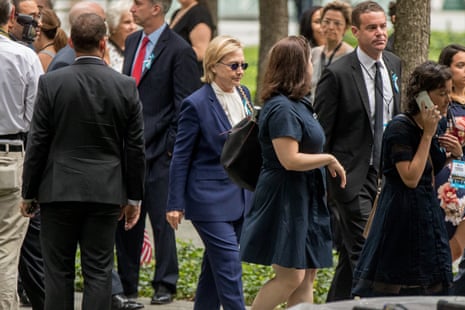Back in the 1840s, contracting pneumonia was a risk to America’s presidential and political health. When William Henry Harrison fell ill a month after a famously chilly outdoor inauguration speech 175 years ago, his death sparked a constitutional crisis over the rules of succession.
Fortunately, both medicine and law have come a long way since. Modern antibiotics mean Hillary Clinton’s diagnosis at 68, the same age Harrison was, is unlikely to throw her off her stride for long. Campaign aides insist she may even be back on the trail by the end of the week.
But though there is no indication that Clinton’s health will require any change of plan for Democrats, the brief scare has underlined how relatively unclear the rules remain for replacing any candidate this late in a presidential campaign.
In theory, either the Republican or Democratic parties can meet to appoint a new candidate should the existing nominee be forced to pull out – something some conservatives are still calling on Trump to do. But in practice, there is little precedent and perhaps only a narrow window for such a dramatic change of heart for either party.
Vice-presidential candidates were changed during the campaigns of 1912 and 1972, both with relatively little consequence, but no presidential nominee has ever dropped out, and the approach of early voting deadlines in a number of states makes it hard to imagine how this would work smoothly today.
In the case of the Democratic National Committee, its rules stipulate that a “special meeting to fill a vacancy on the national ticket shall be held on the call of the chairperson, who shall set the date for such meeting”. But the wording also allows a rules committee to set its own approach, and such a procedure may reopen barely healed wounds in the party, with supporters of Bernie Sanders arguing that he would have the clearest mandate to step in, while the party leadership and White House would be likely to favour Vice-President Joe Biden.
Given time, either Biden or Sanders could prove effective at appealing to the working-class independents drawn to Trump. Both have shown a populist appeal sometimes seen as lacking in the Clinton campaign, which already has a far less certain lead in the polls than many Democrats would like at this stage.
Some in the Clinton campaign may prefer that her vice-presidential candidate, Tim Kaine, step into any vacuum, particularly as the campaign messaging might then require less of an abrupt change. But even this alternative could cede vital momentum to Trump at a tricky time in the race for the White House.
Many states would require court intervention to waive registration deadlines, something that could leave Republicans with the option of legal challenge if they wanted to frustrate the process or preferred to retain Clinton as an opponent.
But the biggest obstacle would be apportioning votes that had already been cast for one of the existing candidates. Many states allow absentee balloting from early October, and some, such as North Carolina, started as early as last Friday.
With a deadlocked supreme court and highly charged congressional atmosphere, a late change could result in a mess to compare to the 1841 Harrison succession row.

Comments (…)
Sign in or create your Guardian account to join the discussion